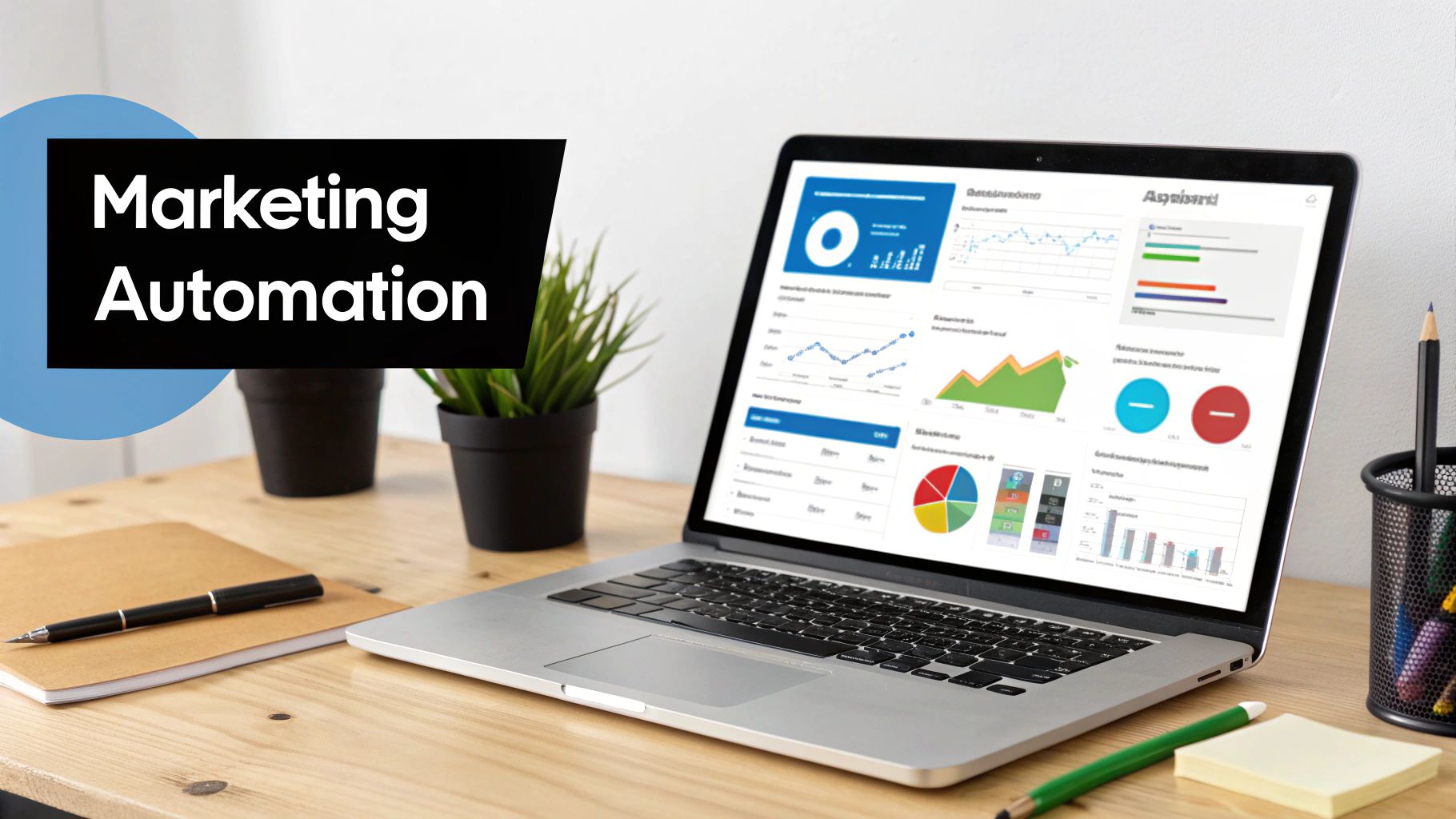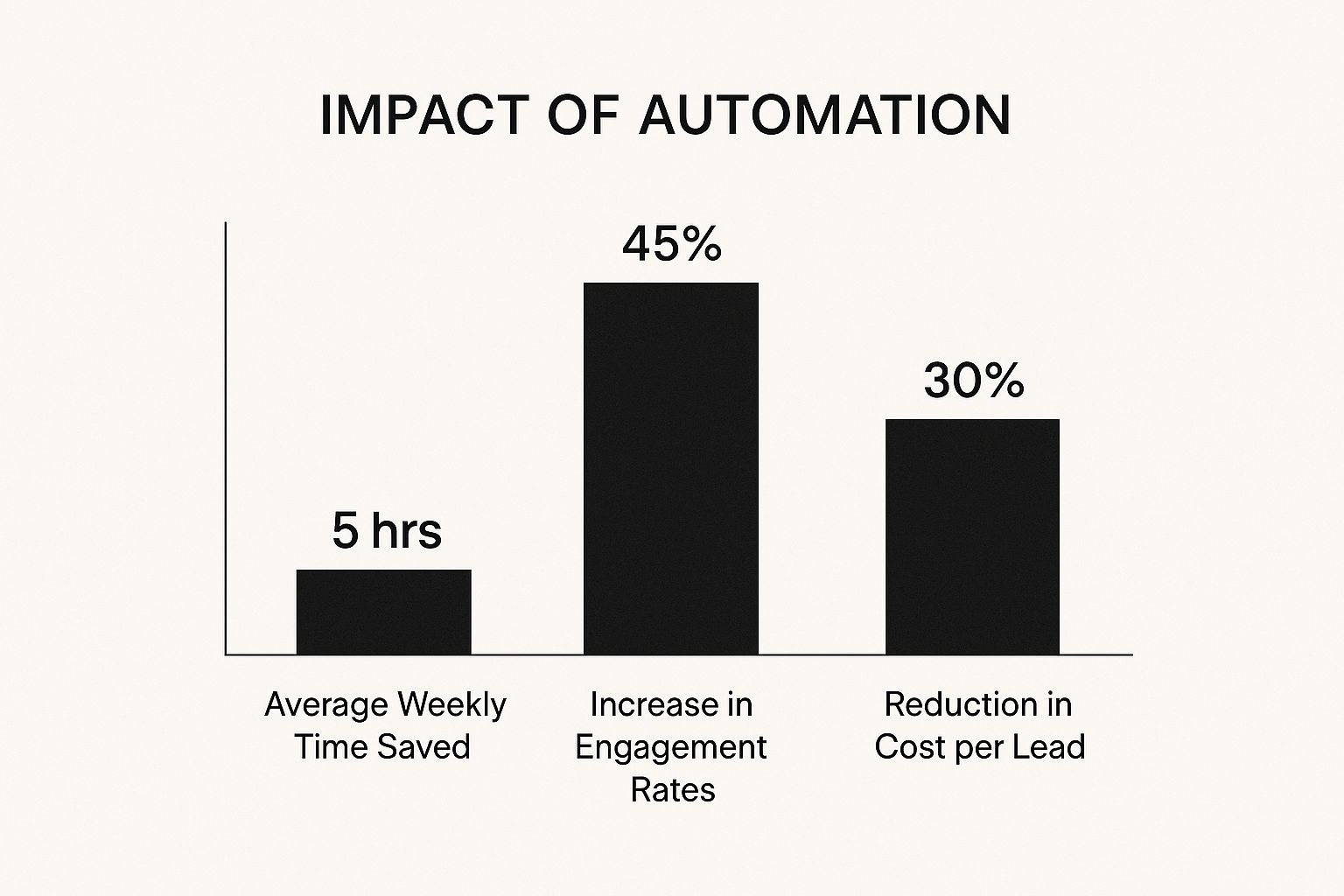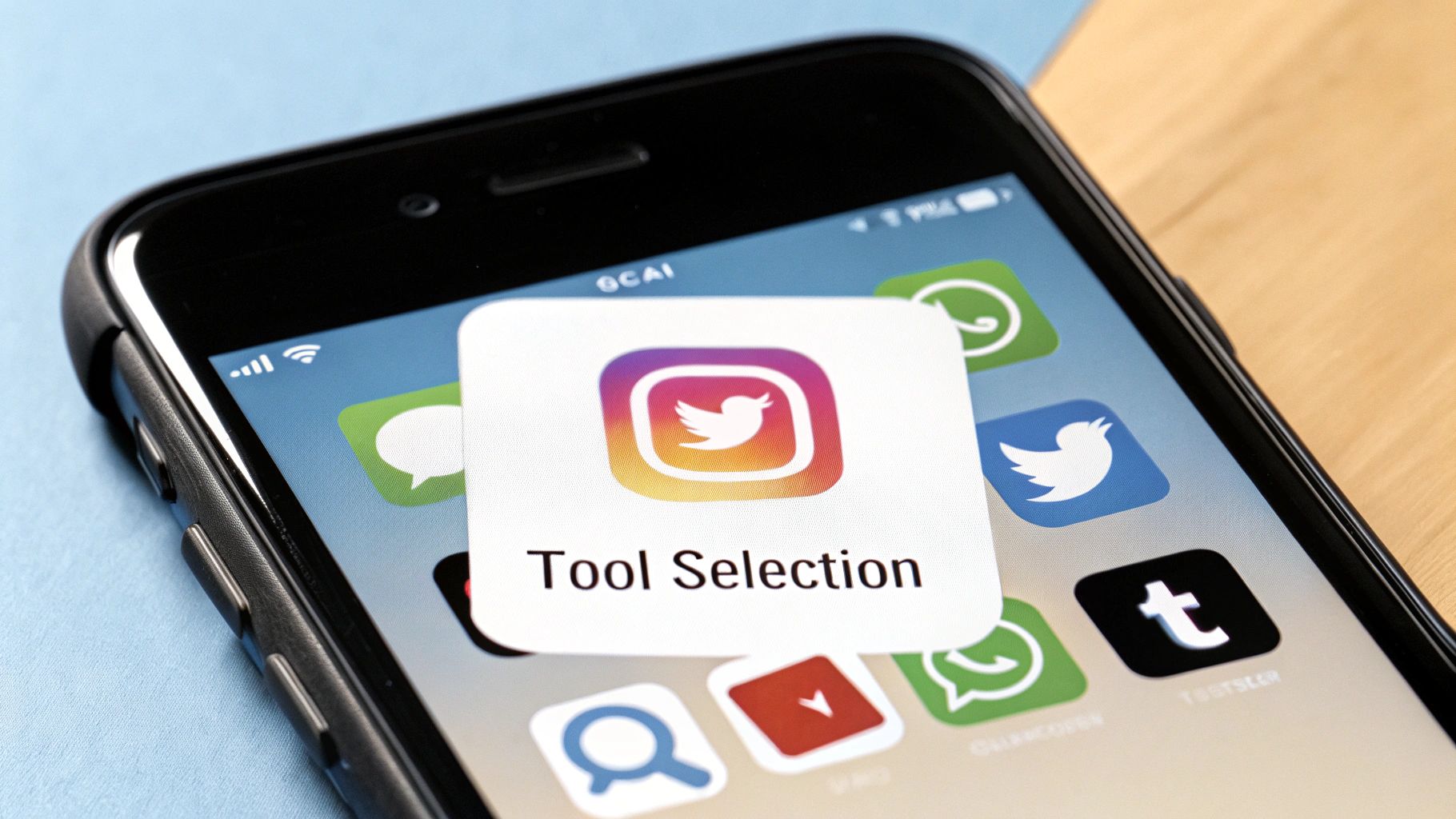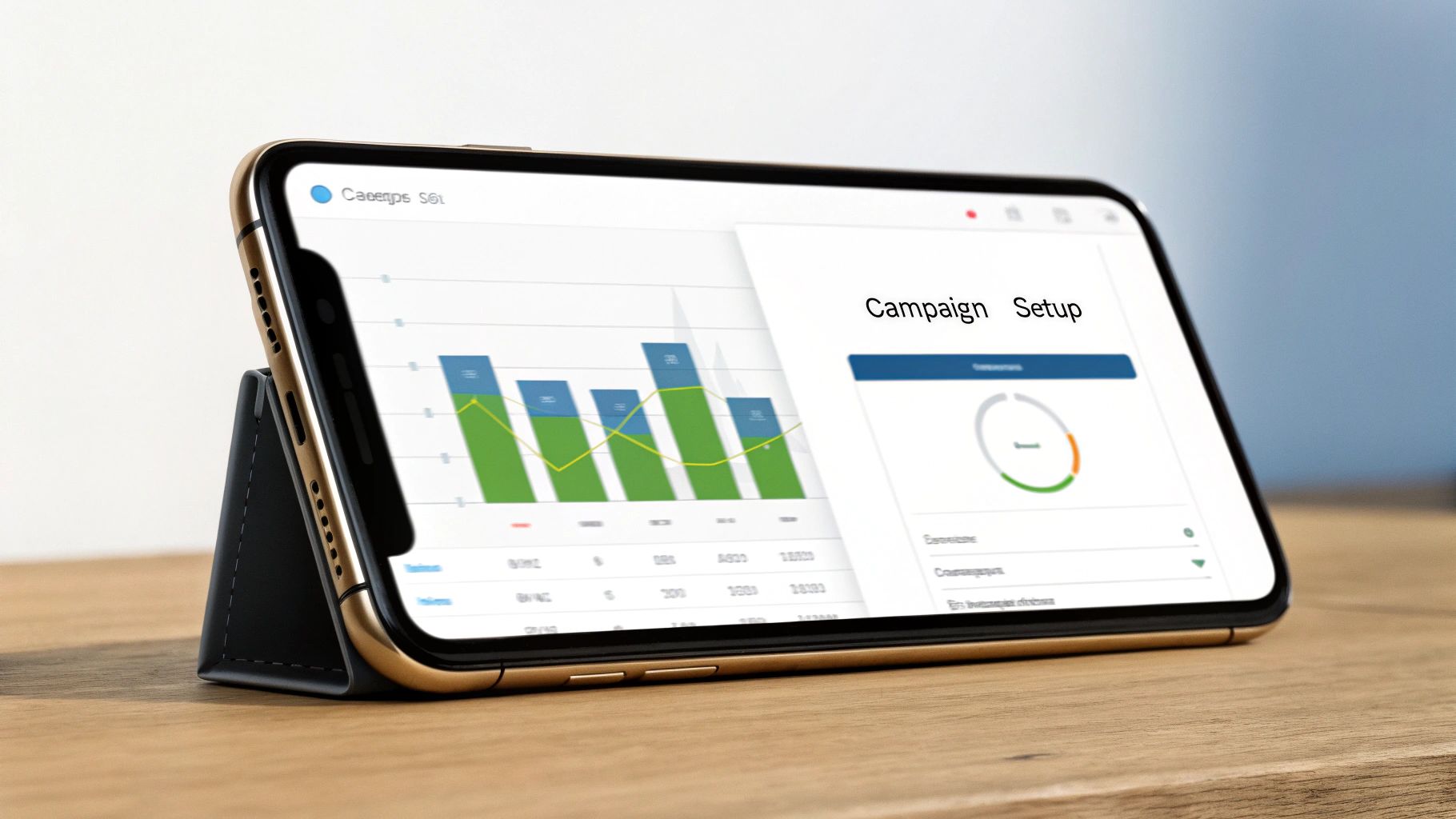Social Media Marketing Automation: Your Complete Playbook
TL;DR - Quick Answer
36 min readBest times to post and tools to use. Get more engagement.
Social Media Marketing Automation: Your Complete Playbook
Understanding Social Media Marketing Automation That Works

Social media automation is about working smarter, not harder. It's about connecting with your audience more efficiently through strategic social media marketing. Think of it like setting your sprinkler system. You control the timing and coverage, and the system handles the consistent watering. Social media automation takes care of repetitive social media tasks, freeing you for strategy and creative content creation.
This allows a more strategic approach to managing your online presence. You can spend more time focusing on what matters: engaging content creation and audience interaction.
Beyond Basic Scheduling: What True Automation Offers
True social media automation is more than just content scheduling. It includes a much broader range of capabilities. Let's explore some of the key features.
-
Automated Responses: Instantly answer common customer questions. Provide store hours or direct users to FAQs. This immediate support improves customer satisfaction.
-
Content Curation and Distribution: Automatically share relevant industry news and articles. Keep your audience engaged and position yourself as a thought leader.
-
Performance Analysis and Reporting: Track important social media metrics like engagement and reach. Generate reports to understand what's working and where you can improve. This data-driven approach ensures your social media strategy remains effective.
-
Campaign Optimization: Refine your social media advertising campaigns based on performance data. Automation can adjust targeting and bidding strategies. This helps maximize your social media ROI.
This helps businesses improve their results. In 2025, an estimated 5.42 billion people will use social media globally. The average person engages with 6.83 different platforms monthly. Marketing automation helps manage these complex interactions. By automating campaigns, companies can save over six hours per week. More statistics are available here: Sproutsocial Social Media Statistics
Finding The Right Balance: Efficiency and Authenticity
Tailoring Automation To Your Business
The best approach to automation varies depending on your business. Factors include company size, industry, and goals. A small business might automate basic tasks like scheduling and responses. A larger enterprise may use advanced tools for personalized content and campaign optimization. Choosing the right tools and strategies is crucial. Effective social media marketing automation involves selecting the right features to enhance your workflows. It's a strategic process that requires planning and thoughtful implementation.
Building Your Automated Strategy From The Ground Up
Creating effective social media marketing automation goes beyond simply scheduling posts. Successful businesses build comprehensive automation frameworks that align with customer behavior and business goals. This involves mapping customer journeys across social media platforms, identifying key automation opportunities, and designing dynamic content workflows.
Mapping the Customer Journey for Automation
Visualize how customers interact with your brand on social media. Consider different entry points, like discovering your profile through a hashtag or clicking an ad link. Then, map their typical steps: visiting your profile, exploring content, engaging with posts, and converting into leads or customers. Understanding these touchpoints reveals prime automation opportunities. For coordinating automated messaging across multiple platforms and channels, explore our Cross-Channel Campaign Management guide with unified campaign strategies. For example, a welcome message for new followers can provide valuable information and encourage further interaction.
Identifying High-Impact Automation Opportunities
Not all social media tasks offer the same potential for automation. Focus on repetitive, time-consuming tasks that don't require unique human input.
- Scheduling posts: Maintain a consistent presence across different platforms.
- Answering FAQs: Provide immediate support for common customer questions.
- Curating content: Share relevant industry news and articles with your audience.
- Monitoring brand mentions: Track conversations about your brand across social media.
- Reporting on performance: Generate regular insights into key social media metrics.
Prioritizing these tasks allows you to achieve quick wins with automation, freeing up your time for more strategic activities. Marketing automation is increasingly vital for businesses scaling their social media presence. Currently, 47% of marketers use automation for their campaigns. This highlights the growing need for personalized experiences across various platforms. Find more detailed statistics here.
To help you prioritize, let's examine some common social media automation tasks and their potential ROI. The table below compares these tasks based on time saved, setup complexity, and overall impact on your business.
Social Media Automation Tasks by ROI Impact Comparison of different automation tasks ranked by time savings and business impact
As you can see, automating FAQs and brand monitoring offers a high ROI due to improved customer service and reputation management. While other tasks save time, their direct impact on ROI might be less pronounced. Consider these factors when planning your automation strategy.
Creating Adaptive Content Workflows
Effective automation adapts to real-time engagement. Instead of static workflows, create dynamic systems that respond intelligently to customer actions. For example, if a user comments on a product post, an automated workflow could trigger a personalized message with more information or a special offer. This personalization strengthens customer relationships.

The infographic above visualizes the impact of social media marketing automation on three key metrics: average weekly time saved, percentage increase in engagement rates, and reduction in cost per lead. The data clearly shows automation yields significant improvements, highlighting its value for businesses optimizing their social media efforts. These gains demonstrate automation's power to improve efficiency, boost engagement, and enhance ROI.
Auditing and Refining Your Current Processes
Before implementing automation, audit your existing social media processes. Identify bottlenecks, inefficiencies, and areas where automation offers the most value. This analysis ensures your automation strategy aligns with your overall business objectives.
By following these steps, you can build a robust social media marketing automation strategy that drives results. This strategic approach helps maximize efficiency and achieve your marketing goals. Remember to continuously analyze and refine your automation workflows for optimal performance. This ongoing optimization helps your business adapt to changing market dynamics and customer behavior.
AI-Powered Content Creation That Feels Human

Building a solid automated strategy is essential for any successful social media presence. However, content remains the most important element. This is where AI-powered content creation offers exciting new possibilities for social media marketing automation. AI can help create engaging content, but remember that maintaining a genuine human touch is key for real connection.
Generating Personalized Content at Scale
One of AI's most significant advantages in social media marketing is its ability to generate personalized content at scale. Imagine crafting individual messages for thousands of followers. This would be an impossible task for a human team. AI can analyze your audience data, including demographics, interests, and past interactions, to create tailored content. This personalized approach can significantly boost engagement and build stronger relationships with your customers.
AI-Driven Content: Finding the Right Balance
Relying solely on AI-generated content can create a robotic and impersonal feel. It’s important to find the right balance between AI efficiency and human creativity. Think of AI as a helpful assistant, not a replacement for your content team. AI tools like Jasper.ai can generate initial drafts, suggest relevant topics, and even optimize content for different platforms. Human oversight, however, remains crucial. It ensures your content aligns with your brand voice and maintains authenticity.
Refining AI-Generated Content for Authenticity
Effective social media automation with AI involves a crucial review and refinement process. Before publishing any AI-generated content, a human should review it. This ensures the message is accurate, on-brand, and resonates authentically with your target audience. Adding that human touch could be as simple as injecting humor, including personal anecdotes, or rephrasing sentences for a more natural, conversational tone. This process lets you leverage the speed and efficiency of AI while preserving the human element in your social media posts.
For example, you could use AI to generate several caption options for a product launch post. Your team could then choose the best option and refine it. Adding a personal story or a call to action specifically tailored to your audience can make a big difference. AI can also analyze audience behavior patterns and suggest the best times to post, further enhancing your social media strategy.
The integration of AI in marketing automation is significantly impacting how businesses manage their social media presence. AI-generated content is increasingly common, with nearly 40% of marketers automating customer journeys. Many of these marketers leverage AI specifically for content creation. Learn more about marketing automation statistics here.
Optimizing Content for Specific Platforms
AI can also help optimize content for different social media platforms. Each platform has its own unique characteristics and audience expectations. AI can tailor content length, format, and tone to maximize engagement on each platform. For instance, a concise, visually-driven post might perform well on Instagram, while a longer, text-based post might be better suited for LinkedIn. This targeted approach ensures your message reaches the right audience in the most effective way possible. By combining the efficiency of AI with human creativity and oversight, you can create compelling social media content that feels both personalized and authentic.
Essential Tools That Actually Deliver Results

Choosing the right social media marketing automation tools can be tough. This section simplifies the process by exploring top platforms, from larger solutions to more budget-friendly choices. We'll look at how successful companies choose tools based on tangible results.
Key Features to Consider in Automation Platforms
Effective automation platforms do more than just schedule posts. They provide advanced features like analytics, cross-platform publishing, audience segmentation, and workflow automation. These tools help businesses efficiently manage their social media.
For instance, audience segmentation helps you target messages effectively, improving campaign performance. This is essential for successful social media marketing automation.
- Advanced Analytics: Monitor key metrics like engagement, reach, and conversions to optimize your social media strategy.
- Cross-Platform Publishing: Control content across multiple social media channels from one place. This simplifies your workflow and saves time.
- Audience Segmentation: Tailor campaigns by dividing your audience into groups based on demographics, interests, or behaviors. This gets your message to the right people.
- Workflow Automation: Automate repetitive tasks like replying to comments or sending direct messages. This lets your team focus on strategy.
These key features separate effective platforms from basic scheduling tools. They let you manage your social media, boost engagement, and get results.
Exploring Leading Social Media Automation Platforms
There are several tools that excel at delivering results. Hootsuite, a comprehensive platform, provides features for scheduling, analytics, and social listening. Other options like Buffer and SproutSocial are also robust for managing multiple accounts and analyzing performance. SocialRails offers affordability along with helpful scheduling and content tools.
To help compare features, pricing, and optimal use cases, let's explore the following table:
Top Social Media Automation Platforms Comparison: Feature comparison of leading automation tools including pricing, capabilities, and best use cases
This table provides a basic comparison. The ideal tool for your business depends on your specific needs and budget. Smaller businesses may like SocialRails, while larger companies may need the features of Hootsuite.
Integrating Multiple Tools for Maximum Efficiency
Many businesses combine different tools to get the most out of each. For example, using Talkwalker for social listening with a scheduling platform like SocialRails can be very effective. This combination lets you monitor conversations and schedule related content from a single dashboard.
Integrating multiple tools can become complicated, however. Choose tools that integrate well and don't duplicate features. This simplifies workflows and prevents unnecessary work. Planning and selection are essential for tool integration.
By considering these key points, businesses can choose social media automation tools that match their goals. It's all about balancing features, cost, and ease of use.
Measuring What Matters: ROI and Performance Optimization
Transforming your social media marketing automation efforts into tangible results requires a strategic approach to performance tracking. This means shifting focus from vanity metrics like likes and shares to data that directly impacts your bottom line. This section explores essential metrics for automated social media campaigns, including conversion rates, customer lifetime value (CLTV), and direct revenue attribution.
Identifying Key Performance Indicators (KPIs) for Automation
First, identify the KPIs that align with your specific business objectives. Are you aiming for increased website traffic, lead generation, or driving direct sales? For e-commerce businesses, focusing on conversion rates and average order value is crucial. B2B companies, however, might prioritize lead generation and CLTV. Selecting the right KPIs helps measure the effectiveness of your automated workflows and demonstrate the value of your social media marketing automation investments.
Setting Up Tracking Systems That Connect to Business Outcomes
Advanced Analytics Techniques for Optimizing ROI
With the right tracking systems in place, you can use advanced analytics techniques to further optimize your ROI. Cohort analysis, for instance, helps you understand the long-term behavior of customers acquired through different automated campaigns. This allows you to see which campaigns are most effective at attracting high-value customers. A/B testing automated content and workflows lets you continuously improve their performance. Experimenting with different messaging, visuals, and call-to-actions helps identify what resonates best with your audience and drives results.
Measuring Customer Satisfaction with Automated Interactions
While financial metrics are important, don't overlook automation's impact on customer satisfaction. Automated interactions, like chatbots and automated responses, can greatly improve customer service efficiency. However, ensure these interactions provide a positive customer experience. Tracking metrics like customer satisfaction scores (CSAT) and Net Promoter Score (NPS) can help assess the effectiveness of your automated customer service. This feedback helps identify areas for improvement and ensures automation enhances the customer journey.
Calculating the True ROI of Your Automation Investments
Calculating the ROI of your social media marketing automation requires considering both costs and benefits. Costs might include software subscriptions and staff training, while benefits can be multifaceted. Increased efficiency, improved customer satisfaction, and higher conversion rates all contribute to the overall ROI. By developing a clear framework for measuring these benefits, you can demonstrate the value of your automation strategy and secure stakeholder buy-in. This involves tracking both direct revenue from automated campaigns and indirect benefits like time saved and improved brand reputation. This holistic approach provides a comprehensive view of the true ROI of your automation initiatives.
Avoiding Costly Mistakes And Implementation Pitfalls
Social media marketing automation offers significant benefits. However, avoiding common pitfalls is essential for success. This section explores challenges businesses face, from over-automation to technical issues, and how to maintain authenticity, ensure compliance, and prevent automation disasters.
The Danger of Over-Automation: Maintaining Authentic Engagement
Automation streamlines tasks, but over-reliance can make your brand seem impersonal. Customers value genuine interaction. Over-automating, especially in customer service, can create negative experiences and damage relationships.
Finding the right balance is key. Automate repetitive tasks like scheduling posts and answering FAQs. Retain human oversight for complex inquiries and personalized responses. This approach maximizes efficiency while preserving authentic engagement.
Technical Failures and Brand Reputation: Creating Backup Systems
Automation depends on technology, which isn't foolproof. Technical glitches, such as incorrect scheduling or chatbot malfunctions, can harm your brand's reputation. Even a simple typo in an automated post can have unintended consequences.
Backup systems are crucial. Regularly review automated processes. Create contingency plans for technical issues. Have a human team member ready to step in if necessary. This prevents automation disasters and protects your brand image.
Navigating Platform Policies and Data Protection: Ensuring Compliance
Social media platforms have specific automation policies. Violating them can lead to account restrictions or permanent bans. Stay informed about platform rules and ensure your automation tools comply.
Ethical Considerations: Transparency and Human Connection
Social media marketing automation raises ethical questions. Transparency with your audience about automated responses is important. You don't need to label every automated message, but avoid deceiving customers into thinking they're interacting with a human when they aren't.
Maintain genuine human connection points throughout the customer journey. Automation should enhance, not replace, human interaction. This builds trust and fosters stronger customer relationships.
Building a Sustainable Automation Strategy
Social media marketing automation isn't a "set it and forget it" solution. It requires ongoing monitoring, analysis, and adjustment. Platforms evolve, customer behavior changes, and your business needs adapt.
Regularly review your automated workflows. Analyze their performance. Make adjustments as needed. This ensures your social media marketing automation strategy stays effective and continues delivering results. By addressing potential pitfalls proactively, you can confidently use automation while protecting your brand and building lasting customer relationships.
Key Takeaways
Social media marketing automation can feel overwhelming. This section simplifies the process and highlights key elements for success, covering actionable frameworks, potential pitfalls, and essential metrics. This practical guidance empowers you to implement automation effectively and achieve sustainable growth.
Actionable Frameworks for Automation Success
What do you hope to achieve with social media marketing automation? Increased brand awareness? More leads? Higher conversion rates? Defining clear objectives is the first step. Your goals will guide your automation strategy.
-
Define Your Target Audience: Understanding your ideal customer is crucial. Knowing their demographics, interests, and online behavior will inform your content and automation workflows.
-
Choose the Right Tools: Select platforms that fit your budget and offer the features you need. Consider integration capabilities, scalability, and reporting functionalities. For example, SocialRails offers helpful scheduling and content generation features.
-
Develop a Content Strategy: A planned content calendar ensures consistent posting and aligns your messaging with your overall marketing goals.
-
Monitor and Analyze: Regularly track key metrics and use data to optimize your automation strategy for continuous improvement.
These frameworks create a strategic foundation for successful social media marketing automation, aligning your efforts with your broader business objectives.
Warning Signs and Pitfalls to Avoid
Automation offers many advantages, but potential downsides exist. Over-automation can make your brand feel impersonal, technical glitches can damage your reputation, and ignoring platform policies can lead to account restrictions.
-
Over-Automation: While automation boosts efficiency, don't automate every interaction. Maintain a human touch; customers value personalized experiences.
-
Technical Issues: Safeguard your efforts with backup systems. Regularly review automated processes and prepare for potential malfunctions.
-
Ignoring Platform Policies: Stay informed about each platform's rules and regulations. Ensure compliance to avoid penalties.
Understanding these pitfalls allows you to mitigate risks and maximize the benefits of automation.
Measuring Success: Metrics That Matter
Focus on data that reflects the real impact of your social media marketing automation. Avoid getting lost in vanity metrics.
-
Conversion Rates: How many social media interactions turn into leads or sales? This metric reveals automation's effectiveness in driving business results.
-
Customer Lifetime Value (CLTV): Measuring the long-term value of customers acquired through social media assesses the overall impact of your automation strategy on revenue.
-
Return on Investment (ROI): Compare the costs of your tools and resources against the revenue generated through automated campaigns to calculate the return on your investment.
These metrics offer clear insights into the performance of your social media marketing automation, justifying your investment and demonstrating its business value.
Implementation Checklists and Timelines
Implementing social media marketing automation can be manageable with a phased approach.
-
Small Businesses: Start by automating basic tasks like scheduling and responses. This can typically be achieved within a few weeks.
-
Medium-Sized Businesses: Implement more complex features like audience segmentation and workflow automation. Allow a few months for setup and optimization.
-
Large Enterprises: Integrate comprehensive automation platforms across multiple departments. This larger-scale implementation may require six months or more.
These timelines provide realistic expectations, enabling effective planning and sustainable growth for businesses of all sizes.
Frequently Asked Questions
What is social media marketing automation?
Social media marketing automation involves using tools and software to automate repetitive tasks like scheduling posts, responding to common questions, monitoring brand mentions, and generating performance reports. It helps businesses maintain consistent social media presence while saving time for strategic activities.
Which social media tasks should I automate first?
Start with high-impact, low-complexity tasks like scheduling posts, answering frequently asked questions, and basic performance reporting. These tasks typically save 5-10 hours per week and are easy to implement without complex setup requirements.
How much time can automation save for social media marketing?
Most businesses save 6-15 hours per week through social media automation. Post scheduling alone can save 5-10 hours weekly, while automated responses to FAQs can save 2-5 hours, and performance reporting can save 2-4 hours per week.
What are the best social media automation tools?
Popular automation tools include Hootsuite (starting at $99/month), Buffer (starting at $6/month), SproutSocial (starting at $249/month), and SocialRails (starting at $15/month). The best choice depends on your budget, business size, and specific feature needs.
Can AI help with automated social media content creation?
Yes, AI can generate content ideas, create initial drafts, optimize posting times, and personalize content at scale. However, human oversight remains essential to ensure authenticity, brand alignment, and quality control before publishing any AI-generated content.
How do I measure the ROI of social media automation?
Measure ROI by tracking conversion rates, customer lifetime value, time saved, and direct revenue attribution from automated campaigns. Compare automation costs (software, setup, training) against benefits like increased efficiency, improved customer satisfaction, and higher conversion rates.
What are common mistakes to avoid with social media automation?
Avoid over-automation that makes your brand feel impersonal, neglecting to create backup systems for technical failures, ignoring platform policies, and automating without human oversight. Always maintain authentic engagement points and review automated processes regularly.
Should I automate all social media interactions?
No, maintain balance between automation and human interaction. Automate repetitive tasks like scheduling and basic FAQs, but keep human oversight for complex customer inquiries, personalized responses, and strategic decision-making to preserve authenticity.
How long does it take to implement social media automation?
Implementation timelines vary by business size. Small businesses can start with basic automation within a few weeks, medium-sized businesses need a few months for complex features, and large enterprises may require 6+ months for comprehensive platform integration across departments.
Social media marketing automation is a powerful tool. By following these key takeaways, you can streamline your efforts, boost engagement, and achieve your marketing goals. Start small, focus on the right metrics, and continuously adapt your strategy for optimal results. SocialRails offers affordable plans starting at just $15/month. Explore our features and start your free trial today: Grow your business with SocialRails
Article created using Outrank
Was this article helpful?
Let us know what you think!
